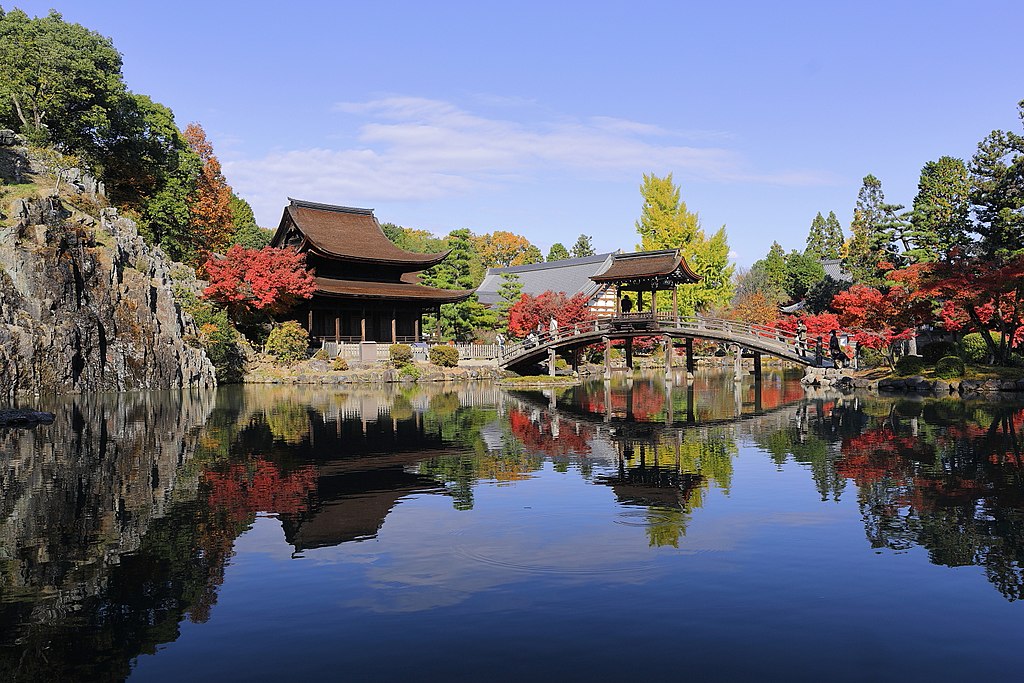Nestled on the scenic border between Aichi and Gifu Prefectures, Tajimi City is a beacon of cultural heritage and serene beauty. It is easily accessible from Nagoya within a 40-minute train ride, making it an ideal destination for those seeking a day trip away from the hustle and bustle of city life. What sets Tajimi apart is its illustrious ceramic industry. This tradition spans centuries and is deeply rooted in the craft of Mino-yaki ceramics, offering a unique glimpse into Japan’s artistic heritage.
However, Tajimi’s allure extends beyond its pottery kilns. Visitors are drawn to its scenic natural beauty, from the gentle flow of the Toki River to the lush greenery that adorns its landscape. Equally captivating is the tranquility of Tajimi’s streets, which echo with the subtle blend of history, culture, and the gentle pace of life that flourishes here. Tajimi offers a unique blend of art, nature, and peace, inviting all who visit to immerse themselves in its serene and storied ambiance as a gateway to exploring the rich tapestry of Japan’s heartland.
Tajimi boasts a ceramic heritage stretching over 1,300 years. This venerable tradition is deeply rooted in the area’s natural bounty, particularly the rich clay resources in the surrounding hills. These resources have been the foundation of Tajimi’s renowned pottery craft. This wealth of natural material has fostered a flourishing ceramic industry, allowing artisans to shape, mold, and fire their creations.
Upon arrival in Tajimi, visitors are greeted by an impressive ceramic wall at the train station. This symbolic gateway introduces the city’s deep-rooted connection to pottery. This artistic installation serves as a warm welcome and a prelude to the city’s rich ceramic legacy, setting the tone for future exploration.
A stroll through Honmachi Oribe Street offers a deeper dive into the heart of Tajimi’s pottery culture. Named after the legendary tea master Furuta Oribe, this Meiji-era street is a living museum of the city’s ceramic industry. The traditional black and white timbered houses that line the street exude a historic charm, inviting visitors to explore. The shops along this picturesque thoroughfare showcase the distinctive green-glazed Mino-yaki ceramics, offering everything from everyday wares to exquisite art pieces. Each shop is a portal to the past, where the timeless beauty of Tajimi’s ceramics can be appreciated in its splendor.
Highlighting the city’s calendar is the annual ceramics festival in April, a vibrant event transforming Tajimi into a bustling marketplace. Over 50 producers from around the region converge to sell their finely crafted wares, turning Honmachi Oribe Street and beyond into a hub of activity. This festival attracts ceramics enthusiasts from all over. It celebrates the enduring legacy and future of Tajimi’s pottery, showcasing the skill, passion, and tradition that has been the city’s hallmark for centuries. It’s a must-visit event for anyone interested in experiencing the city’s cultural vibrancy.
Tajimi’s rich tapestry of cultural and educational attractions extends far beyond its bustling streets and into hands-on learning and artistic exploration. At the heart of this explorative journey is Ceramic Park Mino, a cornerstone of ceramic education and appreciation in the region. This expansive park showcases the area’s renowned Mino-yaki ceramics and offers an interactive space where visitors can immerse themselves in pottery-making. Workshops within the park provide a unique opportunity for guests to mold their creations, guided by skilled artisans, bridging the gap between tradition and modernity and allowing participants to connect with the ancient craft personally.
Beyond the tactile experience of pottery making, Ceramic Park Mino is home to the Museum of Modern Ceramic Art and the Gifu Prefectural Ceramic Museum. These institutions offer a comprehensive look at the evolution of ceramic art, from its humble beginnings to contemporary expressions. The museums’ collections, which range from historical pieces to avant-garde works, highlight ceramics’ versatility and enduring appeal. Through interactive displays and educational programs, visitors can deepen their understanding of the cultural significance and artistic processes behind Mino-yaki and other ceramic traditions.
Further enriching Tajimi’s cultural landscape is the Tajimi Mosaic Tile Museum, a testament to the city’s broader contributions to ceramic arts. Housing an impressive collection of 10,000 examples of tile production, the museum offers insights into ceramic tiles’ technical and aesthetic development throughout history. What sets this museum apart is not only its comprehensive collection but also its
Tajimi’s Ceramics Highlights
Tajimi Ceramics Festival
The Tajimi Ceramics Festival is a spring event that draws around 20,000 ceramics enthusiasts from all over Japan. The festival features local ceramics stores showcasing their finely crafted Mino yaki ceramics at great prices, crafting events, and pottery displays. Held on the second Saturday of April and the following Sunday in Tajimi City, Gifu, the festival offers a unique opportunity to explore the local culture and craftsmanship. A complimentary shuttle bus service is provided from the parking lot of JR Tajimi Station. For more information, visitors can contact the festival organizers at 0572-25-5588.
5-chōme-4-8 Honmachi, Tajimi, Gifu 507-0033 (map)
Ceramic Park Mino
This park is a place to admire ceramics and offers hands-on pottery-making experiences. “For further information, please visit their official website, cpm-gifu.jp.
Ceramic Park Mino, 4 Chome-2-5 Higashimachi, Tajimi, Gifu Prefecture (map)
Honmachi Oribe Street
This area is home to historic Meiji (1868-1912) and early Showa period (1926–1989) merchant houses and warehouses that offer a variety of shops selling traditional and everyday tableware, especially Minoyaki ceramics. The official website for more details is www.oribe-street.com (Guidoor) (CeramicaVR).
Honmachi Oribe Street: 5 Chome Honmachi, Tajimi, Gifu Prefecture (map)
Tajimi Mosaic Tile Museum
Showcasing an impressive collection of 10,000 examples of tile production, this museum also stands out because of its unique architecture by Fujimori Terunobu. More information can be found on their official website: mosaictile-museum.jp.
Tajimi Mosaic Tile Museum, 2082-5 Kasaharacho, Tajimi, Gifu Prefecture (map)
More to see in Tajimi
Eihoji Temple
Established in 1313, Eihoji Temple is a bastion of tranquility and arguably the pinnacle of artificial beauty in Tajimi. This Zen Buddhist sanctuary is nestled within gardens that eloquently mirror the passing seasons—ushering in the vibrant pinks of cherry blossoms in spring, the glorious golds of maple leaves in fall, and the pristine, snow-dappled whites of winter.
Overlooking a grand pond where koi carp serenely swim beneath gracefully arched bridges, the temple’s peaceful atmosphere is further enriched by the harmonious chants of monks in meditation, resonating beside a waterfall that gracefully descends into the pond.
Access to the temple is via a meandering path that winds through ancient cedar groves and bamboo thickets dotted with diminutive Buddhist Jizo statues. This path gradually ascends through the hills, culminating in breathtaking vistas of the surrounding area, encapsulating the essence of tranquility and natural beauty.
Tajimi Catholic Monastery
Tajimi is home to the Tajimi Monastery, a symbol of cultural and spiritual diversity in the region. The monastery, established by German Catholic missionaries led by Father Mohr, connects the East and West, blending religious practices with local traditions. In addition to its religious services, the monastery offers English Mass on the second and fourth Sundays of each month. With its unique Northern European style and prominent spire, the monastery’s architecture stands out in the Japanese setting.
Besides its spiritual and architectural significance, the Tajimi Monastery is famous for its vineyards. The missionaries’ efforts to cultivate their heritage in Tajimi have borne fruit in the form of wines that are celebrated locally and beyond. The annual wine festival in November celebrates this cultural exchange, inviting people from all walks of life to sample the locally produced wines. These wines are available throughout the year and have become popular souvenirs, symbolizing the blend of cultures and traditions that Tajimi represents.
Tomio344456, CC BY-SA 4.0, via Wikimedia Commons




